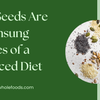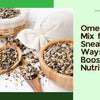Organic Red Split Lentils for Plant-Based Diets
- by K V
Tired of the same old dinner routine? Looking to add a protein punch to your meals without the meat? Then red split lentils are your new best friend! These little red gems are packed with flavour, goodness, and versatility.
They're perfect for vegetarians, vegans, or anyone looking to explore the delicious world of plant-based cooking.
Get ready to ditch the bland and embrace the vibrant with our guide to cooking perfect red split lentils!
Why Choose Organic Red Split Lentils?
First off, let's chat about why you might want to go for organic red split lentils. When you choose organic, you're getting lentils that have been grown without synthetic pesticides or fertilisers.
This means they're better for you and for the environment. Plus, many people find that organic lentils have a richer, more earthy flavour. It's a win-win situation!
Protein Powerhouse
Now, let's get to the good stuff. If you're on a plant-based diet, you're probably always on the lookout for great protein sources. Well, look no further!
Red split lentils are absolutely packed with protein. In fact, about 25% of their calories come from protein. This makes them a fantastic option for building and maintaining muscle.
But it's not just about the amount of protein. Red split lentils also contain all nine essential amino acids. These are the building blocks of protein that our bodies can't make on their own.
While they're not quite a complete protein (they're a bit low in methionine), they come pretty close. Pair them with whole grains, and you've got yourself a complete protein powerhouse!
Iron and Other Nutrients
Iron is another nutrient that can be tricky to get enough of on a plant-based diet. Good news - red split lentils are a great source of iron! This is especially important for vegans and vegetarians, as plant-based iron (non-heme iron) isn't absorbed as easily as iron from animal sources.
To help your body absorb this iron better, try eating your lentils with foods high in vitamin C, like bell peppers or citrus fruits.
But that's not all - these little lentils are also packed with other important nutrients. They're high in fibre, which is great for your digestion and helps keep you feeling full. They also contain folate, potassium, and magnesium. It's like a multivitamin in a tiny red package!
Easy to Cook, Easy to Use
One of the best things about red split lentils is how easy they are to use. Unlike some other types of lentils, red split lentils cook quickly - usually in about 15-20 minutes. They also don't need to be soaked beforehand, which is a big time-saver.
As they cook, red split lentils break down and become soft and creamy. This makes them perfect for soups, stews, and dahls. You can also use them to make veggie burgers, add them to salads, or use them as a base for dips and spreads.
Here's a quick guide on how to cook them:
- Rinse your lentils in cold water to remove any dust.
- For every cup of lentils, use about 3 cups of water or broth.
- Bring the liquid to a boil, then reduce heat and simmer.
- Cook for about 15-20 minutes, or until the lentils are soft and mushy.
- Drain any excess liquid and you're ready to go!
Tasty Recipes to Try
Ready to start cooking? Here are some of our favourite ways to use red split lentils:
- Classic Red Lentil Dahl: Simmer red lentils with onions, garlic, ginger, and your favourite curry spices. Serve over rice for a comforting, protein-packed meal
- Lentil and Vegetable Soup: Add red lentils to your favourite vegetable soup recipe. They'll break down as they cook, making the soup thick and creamy.
- Lentil 'Meatballs': Mix cooked red lentils with breadcrumbs, herbs, and spices. Form into balls and bake for a plant-based version of this classic.
- Red Lentil Hummus: Swap the chickpeas in your usual hummus recipe for cooked red lentils. It's a fun twist on a classic dip!
- Lentil Bolognese: Use red lentils instead of mince in your favourite pasta sauce recipe. It's just as hearty and satisfying as the meaty version.
- Lentil Pancakes: Mix cooked lentils with flour, plant milk, and spices for a protein-packed breakfast option.
- Lentil Salad: Toss cooked and cooled lentils with chopped veggies, herbs, and a tangy dressing for a refreshing lunch.
Storage Tips
To keep your red split lentils at their best, store them in an airtight container in a cool, dry place. They'll keep for up to a year this way. If you live in a humid climate, you might want to keep them in the fridge to prevent any moisture from getting in.
Once cooked, you can store your lentils in the fridge for about 5 days. They also freeze well, so you can cook a big batch and freeze portions for quick meals later on.
A Word on Portion Sizes
While red split lentils are incredibly nutritious, it's worth remembering that they're quite high in carbohydrates. If you're watching your carb intake, you might want to keep an eye on your portion sizes. A good rule of thumb is about 1/2 cup of cooked lentils per serving.
That said, these carbs are complex carbohydrates, which means they're digested slowly and provide steady energy. They're also packed with fibre, which helps regulate blood sugar levels. So while you might want to be mindful of portions, there's no need to be scared of the carbs in lentils!
Nutritional Powerhouse
Let's take a closer look at just how nutritious these little lentils are. In one cup of cooked red split lentils, you'll find:
- About 18 grams of protein
- 15 grams of fibre
- 6.6 mg of iron (37% of your daily needs)
- 731 mg of potassium
- 90 mcg of folate (22% of your daily needs)
- Only 230 calories
This makes them an excellent choice for anyone looking to boost their nutrient intake, especially on a plant-based diet.
Final Thoughts
We hope this guide has shown you just how amazing organic red split lentils can be for your plant-based diet. They're packed with protein, iron, and other essential nutrients, they're easy to cook, and they're incredibly versatile. Whether you're a long-time vegan or just dipping your toes into plant-based eating, red split lentils are a fantastic addition to your pantry.
Remember, eating a balanced diet is key, even when you're plant-based. While red split lentils are nutritious, they shouldn't be your only source of protein. Mix them up with other legumes, grains, nuts, and seeds for a varied and balanced diet.





